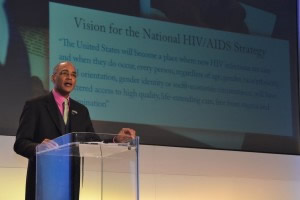
|
By Timothy Harrison, PhD , Senior Policy Advisor, Office of HIV/AIDS Policy , U.S. Department of Health and Human Services
HIV Policy & Programs | November 12, 2011
This is the second in our series of daily highlights from USCA 2011. The National HIV/AIDS Strategy (NHAS) was featured prominently again in several sessions.
Game Changers - Redefining HIV
Yesterday's inspiring and thought provoking plenary session challenged the more than 2,500 participants to contemplate how advances in
HIV are redefining their roles. The session opened with a dramatic presentation of the 30-year history of HIV/AIDS in the U.S.,
highlighting a number of game changers including activism, advances in medication, and Magic Johnson's announcement that he
was HIV positive. Presenters Dr. Calvin Cohen, Director of Research at Community Research Initiative of New England , and
Mr. Phill Wilson, Founder/President of The Black AIDS Institute , then
shared their perspectives on recent game changers, including the NHAS as well as advances in both HIV prevention and treatment, that
hold the potential to shift the course of the epidemic, but demand bold action from the HIV/AIDS community.
 Mr. Wilson
proposed that we are at a "deciding moment" with the tools to end the HIV/AIDS epidemic before us. So, he suggested, the question
before us is no longer whether we can end the epidemic, but does the nation, and especially the HIV/AIDS community, have
the moral and political will to use all of the tools available in an efficient, effective, and compassionate manner
to achieve that goal? He reminded the audience of the wealth of tools now available including diagnostic,
surveillance, prevention, treatment and policy tools. Mr. Wilson also said that while these tools hold
great potential, they - the individuals, activists, researchers, care providers, people living with
HIV/AIDS and others - are the real game changers. He called upon them to build strong and durable
treatment and prevention capacity in the communities hardest hit by HIV/AIDS, and to make
better use of the available resources while advocating for additional ones. Stressing
the importance of changing "business as usual" in order to end the epidemic, he
challenged the audience to talk less about saving particular institutions or
programs and more about what it will take to end the HIV epidemic. "Our
business," he said, "should be about putting ourselves out of business." Mr. Wilson
proposed that we are at a "deciding moment" with the tools to end the HIV/AIDS epidemic before us. So, he suggested, the question
before us is no longer whether we can end the epidemic, but does the nation, and especially the HIV/AIDS community, have
the moral and political will to use all of the tools available in an efficient, effective, and compassionate manner
to achieve that goal? He reminded the audience of the wealth of tools now available including diagnostic,
surveillance, prevention, treatment and policy tools. Mr. Wilson also said that while these tools hold
great potential, they - the individuals, activists, researchers, care providers, people living with
HIV/AIDS and others - are the real game changers. He called upon them to build strong and durable
treatment and prevention capacity in the communities hardest hit by HIV/AIDS, and to make
better use of the available resources while advocating for additional ones. Stressing
the importance of changing "business as usual" in order to end the epidemic, he
challenged the audience to talk less about saving particular institutions or
programs and more about what it will take to end the HIV epidemic. "Our
business," he said, "should be about putting ourselves out of business."
 Dr. Cohen
reviewed the history of advances in HIV medicine and discussed future directions. These included studies underway to better understand
when it is best to start treatment. He noted that the recent HPTN 052 study,
showing that early initiation of treatment can decrease the risk of HIV transmission among discordant heterosexual couples by 96%, is
potentially a game changer for this question. Other advances he examined included efforts underway to develop new agents
that increase convenience and lower toxicity and side effects, and other studies seeking to learn more about how best
to prevent transmission and how to improve adherence to treatment, particularly since studies have recently shown
that people on HIV medication are now living as long as their peers who do not have HIV. Dr. Cohen
reviewed the history of advances in HIV medicine and discussed future directions. These included studies underway to better understand
when it is best to start treatment. He noted that the recent HPTN 052 study,
showing that early initiation of treatment can decrease the risk of HIV transmission among discordant heterosexual couples by 96%, is
potentially a game changer for this question. Other advances he examined included efforts underway to develop new agents
that increase convenience and lower toxicity and side effects, and other studies seeking to learn more about how best
to prevent transmission and how to improve adherence to treatment, particularly since studies have recently shown
that people on HIV medication are now living as long as their peers who do not have HIV.
Spotlight on HHS Agencies Implementing the National HIV/AIDS Strategy
Two sessions yesterday spotlighted the efforts of the Health Resources and Services
Administration (HRSA) and the Substance Abuse and Mental Health Services
Administration (SAMHSA) to implement the NHAS. Both agencies are part of the U.S. Department of Health and Human Services (HHS).
HRSA staff presented highlights of their progress on over 60 action steps for 2010-2011 in
the HHS NHAS Operational Plan . The
majority have been completed or are ongoing, they reported. Ms. Lynn Wegman and Dr. Barbara Aranda-Naranjo, both of HRSA's HIV/AIDS Bureau , highlighted activities including: 1) adding language to all funding announcements requiring compliance with the HHS HIV prevention and treatment guidelines; 2) implementing a prevention with positives initiative in three jurisdictions, and 3) training staff and grantees about the NHAS and HIV/AIDS. Dr. Rene Sterling of HRSA's Bureau of Primary Health Care described how current quality improvement strategies for Federally Qualified Health Centers (FQHCs) are being applied to improve care for PLWH, supporting the second goal of the NHAS. A hot topic of discussion was the fate of stand-alone AIDS Services Organizations (ASOs) given the changes being brought about by the Affordable Care Act, the movement toward Patient-Centered Medical Homes, and uncertainty about the future of the Ryan White Care Act. ASO representatives expressed concern about continuity of care, availability
of medical case management services and culturally and linguistically appropriate support services, should many ASOs close
their doors. Participants proposed solutions for each other and for HRSA including increased technical assistance for
ASOs seeking to become FQHCs, and more information about other evolving options for ASOs. Dr. Shannon Bolan of
HRSA's Bureau of Health Professions shared the
Bureau's activities to enhance HIV training opportunities for the primary care work force. Read more
about some of these activities in Dr. Bolan's recent blog post .
In another session, SAMHSA shared lessons from several grantees who are among the first to receive Federal support for community-based syringe exchange programs as part of the effort to reduce the number of
people who become infected with HIV (see our prior post). SAMHSA authorized these existing grantees to redirect
grant funds for syringe exchange programs as long as local public health and law enforcement agencies
concurred and the grantees did not reduce drug treatment capacity. Grantees shared that starting at
the local community and law enforcement levels, education about and reduction of the stigma
towards needle exchange was required. Other lessons shared included the effectiveness of
using mobile vans so that outreach activities could occur at areas where injecting
drug users congregate, and staffing them with counselors and offering HIV testing.
A participant shared that the light at the end of the tunnel for many of the
clients who participated in these programs started with engagement through
the exchange of needles, which subsequently led to HIV and substance
abuse counseling and linkage to treatment and other positive outcomes.
Finally, the National Minority AIDS Council created an opportunity yesterday for staff from the HHS Office of HIV/AIDS
Policy (OHAP) to meet with representatives from the following communities: Asian American, Native Hawaiian, and Pacific Islander;
Native American; and Young African American gay men. Each group shared specific community concerns about HIV prevention and
service delivery and sustaining effective programs for their communities. They also requested ongoing dialogue about
these issues with HHS officials.
Tune in tomorrow for highlights from today's conference activities.
AIDS.gov team member Cathy Thomas and friend of AIDS.gov Stewart Landers of John Snow, Inc. contributed to this post. ###
Source: Blog.AIDS.gov
|